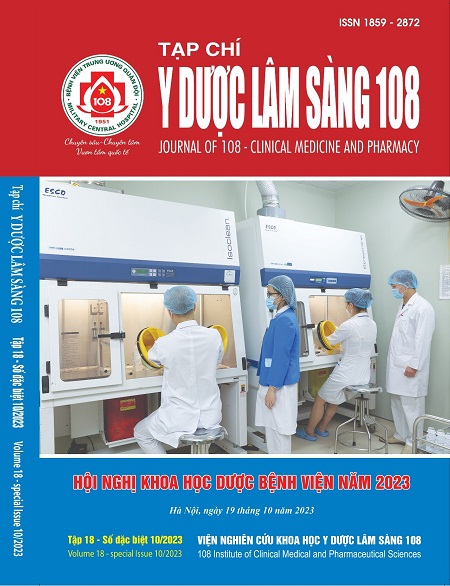Association of trough concentrations of vancomycin with outcomes in pediatric patients with Pneumococcal meningitis
Main Article Content
Keywords
Abstract
Vancomycin is an antibiotic that plays an important role in the treatment of Pneumococcal meningitis in children. However, it remains still unclear whether rapidly reaching the target trough concentration of 10-15mg/L is beneficial in yielding better clinical outcomes. Objective: To evaluate the correlation between vancomycin trough concentrations and the results of treatment pneumococcal meningitis at the National Children's Hospital. Subject and method: Retrospective, cross-sectional study on 37 cases of Pneumococcal meningitis, whose were monitored the vancomycin serum level at the Center for Tropical Diseases, National Children's Hospital since July 2020 to July 2022. Result: The group that reached target trough levels at the first measurement had a shorter fever duration, a lower treatment failure rate with vancomycin, and a lower mortality/ sequelae rate than the other group. But the difference between the two groups was only statistically significant when comparing vancomycin treatment failure rates. Conclusion: Early reaching the target trough concentration improves the outcome of vancomycin treatment in children with Pneumococcal meningitis.
Article Details
References
2. Bệnh viện Nhi Trung ương (2020) Quy trình kỹ thuật theo dõi nồng độ vancomycin trong máu. QTKT.D.001.V1.0.
3. Viladrich PF, Gudiol F, Liñares J et al (1991) Evaluation of vancomycin for therapy of adult pneumococcal meningitis. Antimicrobial agents and chemotherapy 35(12): 2467-2472.
4. Wei WX, Qin XL, Cheng DH et al (2016) Retrospective analysis of vancomycin treatment outcomes in Chinese paediatric patients with suspected Gram-positive infection. 41(6): 650-656. doi: https://doi.org/10.1111/jcpt.12437.
5. Rodriguez CA, Atkinson R, Bitar W et al (2004) Tolerance to vancomycin in pneumococci: Detection with a molecular marker and assessment of clinical impact. The Journal of infectious diseases 190(8): 1481-1487.
6. McCullers JA, English BK, Novak R (2000) Isolation and characterization of vancomycin-tolerant Streptococcus pneumoniae from the cerebrospinal fluid of a patient who developed recrudescent meningitis. The Journal of infectious diseases. Jan 181(1): 369-373.
7. McKamy S, Hernandez E, Jahng M et al (2011) Incidence and risk factors influencing the development of vancomycin nephrotoxicity in children. The Journal of pediatrics. Mar 158(3): 422-6. doi:10.1016/j.jpeds.2010.08.019.
8. Kondo M, Nakagawa S, Orii S et al (2020) Association of Initial Trough Concentrations of Vancomycin with Outcomes in Pediatric Patients with Gram-Positive Bacterial Infection. Biological & pharmaceutical bulletin 43(10): 1463-1468. doi: 10.1248/bpb.b19-01003.
9. Yoo RN, Kim SH, Lee J (2017) Impact of initial vancomycin trough concentration on clinical and microbiological outcomes of methicillin-resistant staphylococcus aureus bacteremia in children. Journal of Korean medical science 32(1): 22-28.
10. Sridharan K, Al-Daylami A, Ajjawi R et al (2019) Vancomycin Use in a Paediatric Intensive Care Unit of a Tertiary Care Hospital. Paediatric drugs. Aug 21(4): 303-312. doi:10.1007/s40272-019-00343-9
11. Cao L, Li Z, Zhang P, Yong S (2022) Relationship between vancomycin trough serum concentrations and clinical outcomes in children: a systematic review and meta-analysis. Antimicrob Agents Chemother 66(8): 0013822. doi:10.1128/aac.00138-22
 ISSN: 1859 - 2872
ISSN: 1859 - 2872
